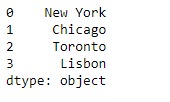Python是進行數據分析的一種出色語言,主要是因為以數據為中心的python軟件包具有奇妙的生態係統。 Pandas是其中的一種,使導入和分析數據更加容易。
Pandas Series.at屬性使我們能夠訪問行/列標簽對的單個值。該屬性類似於loc,因為兩者都提供了基於標簽的查找。
用法:Series.at
參數:沒有
返回:單值
範例1:采用Series.at屬性以訪問給定Series對象中任何特定位置的單個值。
# importing pandas as pd
import pandas as pd
# Creating the Series
sr = pd.Series(['New York', 'Chicago', 'Toronto', 'Lisbon'])
# Print the series
print(sr)輸出:

現在我們將使用Series.at屬性以返回存在於Series對象中給定索引處的元素。
# return the element at the first position
sr.at[1]輸出:

正如我們在輸出中看到的,Series.at屬性已返回“芝加哥”,因為該值位於給定Series對象中的第一位置。
範例2:采用Series.at屬性以訪問給定Series對象中任何特定位置的單個值。
# importing pandas as pd
import pandas as pd
# Creating the Series
sr = pd.Series(['Sam', 21, 'Alisa', 18, 'Sophia', 19, 'Max', 17])
# Print the series
print(sr)輸出:

現在我們將使用Series.at屬性以返回存在於Series對象中給定索引處的元素。
# return the element at the first position
sr.at[5]輸出:

正如我們在輸出中看到的,Series.at屬性已返回“ 19”,因為該值位於給定Series對象中的第5個位置。
相關用法
- Python pandas.map()用法及代碼示例
- Python Pandas Series.str.len()用法及代碼示例
- Python Pandas.factorize()用法及代碼示例
- Python Pandas TimedeltaIndex.name用法及代碼示例
- Python Pandas dataframe.ne()用法及代碼示例
- Python Pandas Series.between()用法及代碼示例
- Python Pandas DataFrame.where()用法及代碼示例
- Python Pandas Series.add()用法及代碼示例
- Python Pandas.pivot_table()用法及代碼示例
- Python Pandas Series.mod()用法及代碼示例
- Python Pandas Dataframe.at[ ]用法及代碼示例
- Python Pandas Dataframe.iat[ ]用法及代碼示例
- Python Pandas.pivot()用法及代碼示例
- Python Pandas dataframe.mul()用法及代碼示例
- Python Pandas.melt()用法及代碼示例
注:本文由純淨天空篩選整理自Shubham__Ranjan大神的英文原創作品 Python | Pandas Series.at。非經特殊聲明,原始代碼版權歸原作者所有,本譯文未經允許或授權,請勿轉載或複製。
